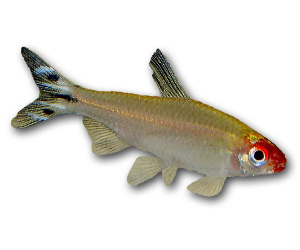Rummy Nose Tetra

Quick Stats
| Size | Up to 2" (5cm) |
|---|---|
| Tank | 60 litres + for a small school |
| Swimming Area | Middle |
| Ph | 6.0 to 7.5 |
| Temperature | 74ºF to 82ºF (23-29°C) |
| Food | Flakes and frozen foods as well as live. |
Common Name:
Rummy Nose Tetra
Distribution:
Lower Amazon region, around Aripiranga and Paraguay.
Colouration:
This is a distinctive looking little tetra with black and white "checkerboard" markings on its tail and a bright red nose, for which it is named. The red nose is actually the best indication of the fish's health and well-being--when it is feeling ill at ease or not in tiptop shape (for example, when first introduced to the tank), this red will fade to a dull pink, barely distinguishable from its unremarkable gray body color.
Lifespan:
5 years.
Maintenance:
10 to 20% weekly water change. The rummy-nose tetra is an excellent fish for the community tank once it is adjusted to its surroundings, but this initial adaptive phase can be a bit longer than for some fish. In the meantime, it tends to be sensitive to water quality, so test this frequently. It does not take well to addition of salt and many chemical additives, and pH fluctuations can kill it. It must be kept with at least 3 members of its own species, or else it will sulk in the corner and show signs of stress. Healthy species will adapt eventually to a well-planted tank and school actively in and out of every corner of the aquarium, their noses glowing brightly.
Feeding:
Feeding is never a problem as it will eat all flake frozen as well as live food.
Substrate:
Dark sandy material.
Tank Decor:
The tank should be well planted with artificial or live plants. A dark sandy substrate is best to allow this beautiful fish to display its stunning colouration.
Filtration:
Standard filtration for the size of tank.
Biotype:
A planted South American Riverbank setup.
Breeding:
This is a delicate fish and is very hard to breed. Similar to the neon tetra, the breeding tank should be sterile. Provide a large tank with lots of plants and very soft water. Several pairs should be placed together. After a long period of acclimation and conditioning they may spawn. A small number of eggs are produced which will hatch in about thirty hours.